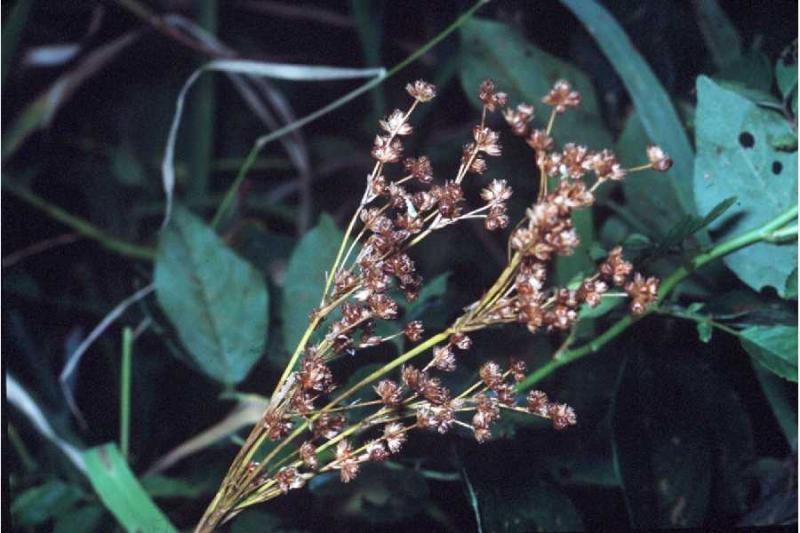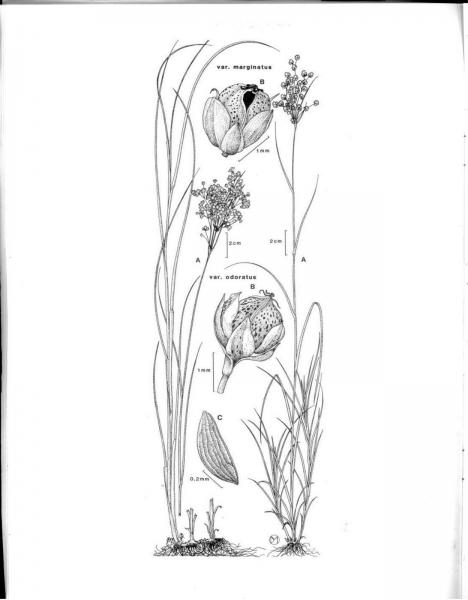Large Grass-leaved Rush
Juncus biflorus Ell.
- Class
- Monocotyledoneae (Monocots)
- Family
- Juncaceae (Rush Family)
- State Protection
- Endangered
Listed as Endangered by New York State: in imminent danger of extirpation in New York. For animals, taking, importation, transportation, or possession is prohibited, except under license or permit. For plants, removal or damage without the consent of the landowner is prohibited.
- Federal Protection
- Not Listed
- State Conservation Status Rank
- S1
Critically Imperiled in New York - Especially vulnerable to disappearing from New York due to extreme rarity or other factors; typically 5 or fewer populations or locations in New York, very few individuals, very restricted range, very few remaining acres (or miles of stream), and/or very steep declines.
- Global Conservation Status Rank
- G5
Secure globally - Common in the world; widespread and abundant (but may be rare in some parts of its range).
Summary
Did you know?
You may not find this species in some plant books because it is often lumped under other species, usually Juncus marginatus. In New York it is recognized as a separate species based upon work done by W.N. Knapp on the status of Juncus longii (Weldy, Troy and David Werier 2010).
State Ranking Justification
There are three existing populations but no detailed surveys have been done to determine population size and quality. There are 15 historical records from the early 1900s through 1963 that need to be resurveyed.
Short-term Trends
Short-term trends are unknown because existing populations have only been surveyed once.
Long-term Trends
Populations have probably declined somewhat over the last 100 years but more surveys are needed of older records to determine long-term trends.
Conservation and Management
Threats
One population is threatened by trampling, off-road vehicles, and the displacement by exotic species.
Conservation Strategies and Management Practices
The small natural areas where these plants occur need to be maintained in a natural condition by preventing woody succession and direct disturbance by people from surrounding residential areas. The presence of exotic species, especially Phragmites, needs to be monitored and removed when they appear.
Research Needs
More research is needed to determine specific habitat preferences in order to narrow down areas to survey.
Habitat
Habitat
In New York this species has been seen on a damp, mowed roadside, a coastal plain pondshore and a natural wet opening in successional pitch pine barrens surrounded by development (New York Natural Heritage Program 2012). Moist or wet meadows and shores (Gleason and Cronquist 1991).
Associated Ecological Communities
- Coastal plain pond shore
(guide)
The gently sloping shore of a coastal plain pond with seasonally and annually fluctuating water levels. Plants growing on the pond shore vary with water levels. In dry years when water levels are low there is often a dense growth of annual sedges, grasses, and herbs. Submerged and floating-leaved aquatic plants, such as fragrant waterlily and pondweeds, may become "stranded" on the exposed shore. In wet years when the water level is high only a few emergents and floating-leaved aquatics may be noticeable. T
- Pitch pine-oak forest
(guide)
A mixed forest that typically occurs on well-drained, sandy soils of glacial outwash plains or moraines; it also occurs on thin, rocky soils of ridgetops. The dominant trees are pitch pine mixed with one or more of the following oaks: scarlet oak, white oak, red oak, or black oak.
Associated Species
- Myrica pensylvanica
- Prunus
Range
New York State Distribution
This occurs only in eastern Suffolk County on Long Island.
Global Distribution
This is primarily a species of the midwestern, south-central and southeastern US where it only reaches extreme northern Florida. Its northeastern range limit includes Pennsylvania, New York and Massachusetts where it is rare.
Identification Comments
General Description
This rush grows up to 2-5 dm tall, in clumps from a coarse thick rhizome. The principal leaves are flat, 1-3 mm wide, with 3 prominent veins, lacking septa, and with rounded articles at the base of the blades. The terminal inflorescence has 20-200 flower clusters with 2-5 flowers per cluster. The outer tepals are lanceolate, 2.1-3.1 millimeters long and long-pointed. The inner tepals are 2.0-3.3 millimeters long, usually with a rounded tip although sometimes they are more pointed. There are 3 stamens that are tipically longer than the outer tepals. The ovoid to rounded capsule is longer than the tepals and brown with red speckles. The apex is blunt or rounded. The seeds are tapered at both ends, light brown, 0.5-0.7 mm long with small points at each tip. They are covered with transverse chambered lines.
Best Life Stage for Proper Identification
The best time to identify this species is when it is in fruit.
Similar Species
The more common and widespread Juncus marginatus is closely related but it only has 5-15 flower clusters per inflorescence and with 6-20 flowers each. The rhizomes are thin and not coarse and not very conspicuous. The stamens are usually shorter than the outer tepals. These two species are the only Juncus species in New York with flat leaves and flowers in clusters.
Best Time to See
Fruits are visible from July to early November.
- Fruiting
The time of year you would expect to find Large Grass-leaved Rush fruiting in New York.
Large Grass-leaved Rush Images
Taxonomy
Large Grass-leaved Rush
Juncus biflorus Ell.
- Kingdom Plantae
- Phylum Anthophyta
- Class Monocotyledoneae
(Monocots)
- Order Juncales
- Family Juncaceae (Rush Family)
- Order Juncales
- Class Monocotyledoneae
(Monocots)
- Phylum Anthophyta
Additional Common Names
- Grass-leaf Rush
Synonyms
- Juncus aristulatus Michx.
- Juncus biflorus Ell.
- Juncus marginatus var. aristulatus (Michx.) Coville
- Juncus marginatus var. odoratus Torr.
- Juncus odoratus (Torr.) Steud.
Additional Resources
Best Identification Reference
Flora of North America Editorial Committee. 2000. Flora of North America north of Mexico. Vol. 22. Magnoliophyta: Alismatidae, Arecidae, Commelinidae (in part), and Zingiberidae. Oxford Univ. Press, New York. xxiii + 352 pp.
Other References
Clemants, Steven E. 1990. Juncaceae (rush family) of New York State. Contributions to a flora of New York State VII Richard S. Mitchell, ed. New York State Museum Bulletin No. 475. 67 pp.
Fernald, M.L. 1950. Gray's manual of botany. 8th edition. D. Van Nostrand, New York. 1632 pp.
Gleason, Henry A. and A. Cronquist. 1991. Manual of Vascular Plants of Northeastern United States and Adjacent Canada. The New York Botanical Garden, Bronx, New York. 910 pp.
Holmgren, Noel. 1998. The Illustrated Companion to Gleason and Cronquist's Manual. Illustrations of the Vascular Plants of Northeastern United States and Adjacent Canada. The New York Botanical Garden, Bronx, New York.
Knapp, W.M. 2004. Taxonomic status of Juncus longii, a putative taxon within the Juncus marginatus complex (Juncaceae Graminifolii) [abstract only]. Southeastern Biology 51: 134.
Mitchell, Richard S. and Gordon C. Tucker. 1997. Revised Checklist of New York State Plants. Contributions to a Flora of New York State. Checklist IV. Bulletin No. 490. New York State Museum. Albany, NY. 400 pp.
New York Natural Heritage Program. 2010. Biotics database. New York Natural Heritage Program. New York State Department of Environmental Conservation. Albany, NY.
New York Natural Heritage Program. 2024. New York Natural Heritage Program Databases. Albany, NY.
Weldy, T. and D. Werier. 2010. New York flora atlas. [S.M. Landry, K.N. Campbell, and L.D. Mabe (original application development), Florida Center for Community Design and Research http://www.fccdr.usf.edu/. University of South Florida http://www.usf.edu/]. New York Flora Association http://newyork.plantatlas.usf.edu/, Albany, New York
Links
About This Guide
This guide was authored by: Stephen M. Young
Information for this guide was last updated on: September 6, 2012
Please cite this page as:
New York Natural Heritage Program. 2024.
Online Conservation Guide for
Juncus biflorus.
Available from: https://guides.nynhp.org/large-grass-leaved-rush/.
Accessed July 27, 2024.

